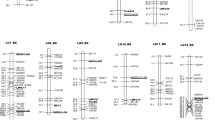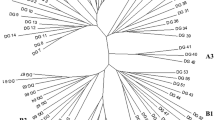Summary
We have developed a restriction fragment length polymorphism (RFLP) linkage map in diploid alfalfa (Medicago sativa L.) to be used as a tool in alfalfa improvement programs. An F2 mapping population of 86 individuals was produced from a cross between a plant of the W2xiso population (M. sativa ssp. sativa) and a plant from USDA PI440501 (M. sativa ssp. coerulea). The current map contains 108 cDNA markers covering 467.5 centimorgans. The short length of the map is probably due to low recombination in this cross. Marker order may be maintained in other populations even though the distance between clones may change. About 50% of the mapped loci showed segregation distortion, mostly toward excess heterozygotes. This is circumstantial evidence supporting the maximum heterozygote theory which states that relative vigor is dependent on maximizing the number of loci with multiple alleles. The application of the map to tetraploid populations is discussed.
Similar content being viewed by others
References
Bingham ET (1991) Registration of isogenic populations of diploid and tetraploid alfalfa, W2xiso-1 and W4xiso-1. Crop Sci 31:496
Bingham ET, McCoy TJ (1979) Cultivated alfalfa at the diploid level: origin, reproductive stability, and yield of seed and forage. Crop Sci 19:97–100
Brummer EC, Kochert G, Bouton JH (1991) RFLP variation in diploid and tetraploid alfalfa. Theor Appl Genet 83:89–96
Busbice TH, Hill RR Jr, Carnahan HL (1972) Genetics and breeding procedures. In: Hanson CH (ed) Alfalfa science and technology. ASA, Madison, Wisconsin, pp 263–318
Dunbier MW, Bingham ET (1975) Maximum heterozygosity in alfalfa: results using haploid-derived autotetraploids. Crop Sci 15:527–531
Lander ES, Green P, Abrahamson J, Barlow A, Daly MJ, Lincoln SE, Newburg L (1987) MAPMAKER: An interactive computer package for constructing primary genetic linkage maps of experimental and natural populations. Genomics 1:174–181
Lesins K, Gillies CB (1972) Taxonomy and cytogenetics of Medicago. In: Hanson CH (ed) Alfalfa science and technology. ASA, Madison, Wisconsin, pp 53–86
Quiros CF, Bauchan GR (1988) The genus Medicago and the origin of the Medicago sativa complex. In: Hanson AA, Barnes DK, Hill RR (eds) Alfalfa and alfalfa improvement. ASA, Madison, Wisconsin, pp 93–124
Reiter RS, Williams JGK, Feldmann KA, Rafalski JA, Tingey SV, Scolnik PA (1992) Global and local genome mapping in Arabidopsis thaliana by using recombinant inbred lines and random amplified polymorphic DNAs. Proc Natl Acad Sci USA 89:1477–1481
Sorensen EL, Byers RA, Horber EK (1988) Breeding for insect resistance. In: Hanson AA, Barnes DK, Hill RR (eds) Alfalfa and alfalfa improvement. ASA, Madison, Wisconsin, pp 859–902
Wu KK, Burnquist W, Sorrells ME, Tew TL, Moore PH, Tanksley SD (1992) The detection and estimation of linkage in polyploids using single-dose restriction fragments. Theor Appl Genet 83:294–300
Author information
Authors and Affiliations
Additional information
Communicated by G.E. Hart
Rights and permissions
About this article
Cite this article
Brummer, E.C., Bouton, J.H. & Kochert, G. Development of an RFLP map in diploid alfalfa. Theoret. Appl. Genetics 86, 329–332 (1993). https://doi.org/10.1007/BF00222097
Received:
Accepted:
Issue Date:
DOI: https://doi.org/10.1007/BF00222097




